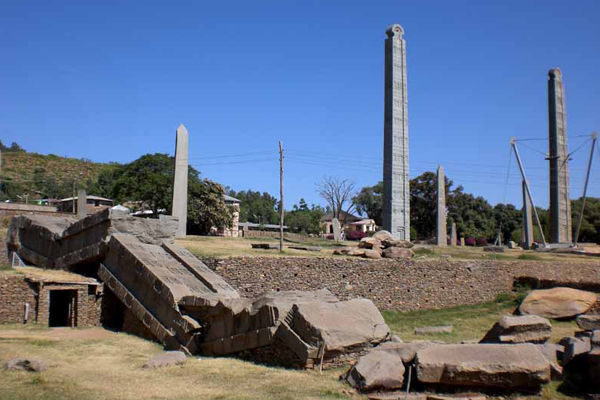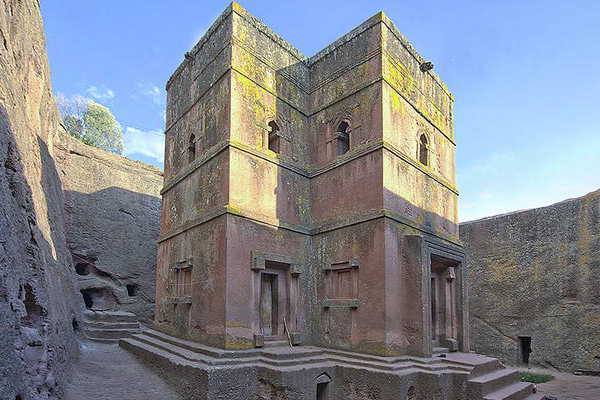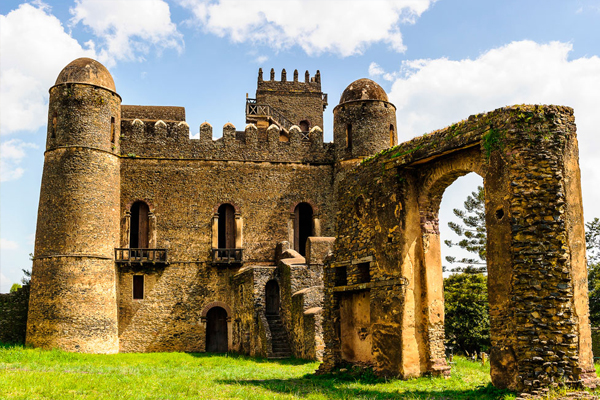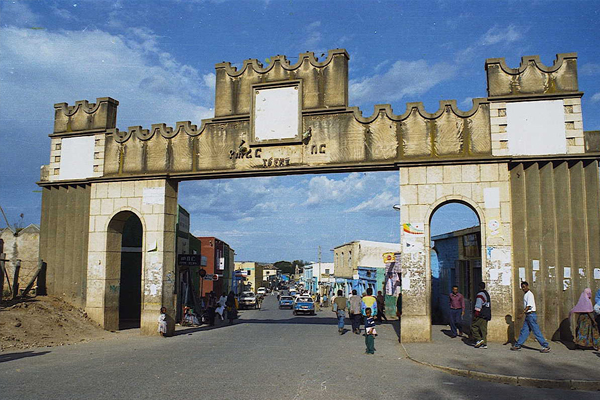Axum-Africa’s ancient city
 Some 365 kilo meters northeast of Gondar lies the town of Axum, Ethiopia’s oldest city. Axum dates back some 2,000 years to when it was the hub of the Axumite Empire. The Queen of Sheba made it her capital 1000 years before Christ. The Ethiopian Orthodox Church was founded here in the fourth century and Axum remains the holist city of the Ethiopian Orthodox Church.
Some 365 kilo meters northeast of Gondar lies the town of Axum, Ethiopia’s oldest city. Axum dates back some 2,000 years to when it was the hub of the Axumite Empire. The Queen of Sheba made it her capital 1000 years before Christ. The Ethiopian Orthodox Church was founded here in the fourth century and Axum remains the holist city of the Ethiopian Orthodox Church.
All that remains now of Axum’s past glories are the huge granite stelae (pillars), some fallen and some still perpendicular. Made of single blocks of granite, the tallest stood over 33 meters high-the largest monolith in the world. The biggest now standing is 23 meters high.
Today, the Arc, which once housed the Ten Commandments, remains well hidden in Axum. It is guarded by a select group of monks, whose sole commitment is to protect the sacred vessel. Axum is also known for its massive, towering sculptures that are thousand years old.
All three section of the 1,700 years old Axum obelisk has arrived back in Ethiopia, 68 years after it was looted by ltalian fascists. Many Ethiopians see the obelisk as an important national symbol-its return has been subject to great national anticipation and excitement. Seized back in 1937 by Italian troops, it was taken to Rome where it remained, despite a 1947 UN agreement to return it to Ethiopia. It was eventually dismantled into three pieces in 2004 in preparation for its journey home, an operation which is costing ltaly an estimated 6 million euros (£4.1 million). The monument is re-erected on its original place.
The Grave of King Kaleb and the Grave of King Gebre Meskel, the reputed Bath of the Queen of Sheba, and a Museum are other historical attractions in the town. The ruins a few kilometers out of town to the north were once the Palace of Sheba apparently. The entrance stairs and floor plan are intact and the palace had over 50 rooms.
Lalibela- Creation of Angles
 Ever since the first European to describe the rock churches if Lalibela, Francisco Alvarez, came to this holy city between 1521 and 1525, travelers have tried to put into words their experiences. Praising it as a “New Jerusalem” a “New Golgotha”, the “Christian Citadel in the Mountains of Wondrous Ethiopia” . The inhabitants of the monastic township of Roha-Lalibela in Lasta, province of Wollo, dwelling in two storeyed circular huts with dry stonewalls, are unable to believe that the rock churches are entirely made by man. They ascribe their creation to one of the last kings of the Zagwe dynasty, Lalibela, who reigned about 1200 A.D.
Ever since the first European to describe the rock churches if Lalibela, Francisco Alvarez, came to this holy city between 1521 and 1525, travelers have tried to put into words their experiences. Praising it as a “New Jerusalem” a “New Golgotha”, the “Christian Citadel in the Mountains of Wondrous Ethiopia” . The inhabitants of the monastic township of Roha-Lalibela in Lasta, province of Wollo, dwelling in two storeyed circular huts with dry stonewalls, are unable to believe that the rock churches are entirely made by man. They ascribe their creation to one of the last kings of the Zagwe dynasty, Lalibela, who reigned about 1200 A.D.
According to legend before the throne of Ethiopia was restored to its rightful rulers, upon command of God and with the help of Angels, Lalibela’s pious zeal converted the royal residence of the Zagwe in the town of Roha in to a prayer of stone.
In Laliabela itself you will find two main groups of churches, one on each side of the river Jordan and one other church set apart from the rest. The town of Roha-Lalibela lies between the first and the second group of churches. It is situated on the higher part of a mountain-terrace on a vast plateau of rock. At Timkat (Ethiopian Epiphany. Ca. January 19) a vivid ritual unfolds before the spectator: here the dances of the priests take place after the annual repetition of mass baptism in the river Jordan.
There are twelve churches and chapels, including various shrines. Four churches are monolithic in the strict sense; the remainder is excavated churches in different degrees of separation from the rock. The walls of the trenches and courtyards contain cavities and chambers sometimes filled with the mummies of pious monks and pilgrims.
Types of Churches
There are three basic types of rock churches in Ethiopia:-
1. Built-up cave churches, which are ordinary structures inside a natural cave (Makina Medhane Alem and Yemrehanna Krestos near Lalibela are examples of this style).
2. Rock-hewn cave churches, which are cut inwards from a more or less vertical cliff face sometimes using and widening an existing natural cave (Abba Libanos in Lalibela).
3. Rock-hewn monolithic churches, which imitate a built-up structure but are cut in one piece from the rock and separated from it all round by a trench. Most churches of this type are found in or near Lalibela (Bet Medhane Alem. Bet Maryam. Bet Giorgis, and others). Nowhere else in the world are constructions of this particular kind found.
Gondar – Camelot of Africa
Gondar is 50 kilometers north of Lake Tana, 500 Kilometers north of Addis Ababa and nestles in the foothills of the Simien mountains at 2,200 meters above sea level. Gondor was the capital of Ethiopia from the rise of Fasilades to the fall of Tewodros (1855 – 68) which is reflected in the many castles and palaces in the city.
Castles
 The city’s main imperial precinct, known as the Royal Enclosure, covers an area of 7.7 hectares and contains five castles, raised walkways and connecting tunnels surrounded by high stone walls.
The city’s main imperial precinct, known as the Royal Enclosure, covers an area of 7.7 hectares and contains five castles, raised walkways and connecting tunnels surrounded by high stone walls.
The oldest of these is the Castle of Fasildes. Built of stone in the mid-17th century it reflects a number of influences, Axumite, Portuguese and Indian. The upper storey offers panoramic views and Lake Tana is Visible on a clear day.The castle has been renovated recently.
Fasilades grandson,Iyasu- the great, built his own castle and decorated it with Ivory,gold and precious stones but an earthquake in the early 19th caused sever damage.
Other attractions
The palace of Ras Beit, was built in the 18th century as a private residence of the famous king maker, Ras Mikael Sehul and has been in continues occupation ever since.
Bath of Fasilades is a sunken pool still used for the Timkat Festival in January.
One of the most spectacular art painted churches in Ethiopia Debre Birhan Selassie can be seen here.
Yeha
Ethiopia’s historic route begins with a glance at the tantalizing remains of Yeha-the country’s earliest high civilization.
In a remote part of Tigray region, Yeha lies several hours drive from the more accessible city of Axum, the journey takes you on rough tracks through dramatic highland scenery and eventually ends in a beautiful and serene agricultural hamlet. It is there, close to a much more recent Christian church, that you my see the towering ruins of Yeha’s Temple of the Moon-built more than 2,500 years ago, in Sabaean times.
Harar – The 4th sacred city of Islam
 Harar is a walled city which stands on the eastern wall of the Great Rift Valley and is the provincial capital of Ethiopia’s largest administrative region, Hararge. The city’s location gives wonderful views of the surrounding country-the vast Danakil desert to the north, the fertile Harar Mountains to the west, and the cattle rich Ogaden plains to the south.
Harar is a walled city which stands on the eastern wall of the Great Rift Valley and is the provincial capital of Ethiopia’s largest administrative region, Hararge. The city’s location gives wonderful views of the surrounding country-the vast Danakil desert to the north, the fertile Harar Mountains to the west, and the cattle rich Ogaden plains to the south.
Harar was a fiercely religious city and was a forbidden city (closed to visitors), until 1887 when Menelik restored central rule. With its 99 mosques, including the 16th century Grand Mosque with is beautiful twin towers and slender minaret, it is considered to be the fourth most holy city in Islam after Mecca, Medina and the Dome of the Rock in Jerusalem.
Medhane Alem church, built at the end of the 19th century, is in the town centre and contains excellent examples of traditional regional art.
The community Museum, also in the town centre, has displays relating to the way of life in earlier times.
The 16th century Grand Mosque, with is beautiful twin towers and slender minaret lies on the road to the Erer Gate women are not permitted inside the mosque.
The vibrant market place is regarded as one of the most colorful in all Ethiopia.
Off the road from the Sauga Gate to the main market lies Ras Mekonen’s house where Haile Selassie spent most of his childhood.
The house of the famous French poet Arthur Rambus is unique in its architectural design.
The Ahmar Mountains around Harar produce some of the best coffee in Ethiopia.
The Hyena Men of Harar collect offal and bones to feed to the wild hyenas usually about 100 meters outside the Fallana Gate of the old city walls of the town. Hyenas appear just after sunset to take food from their hands.





